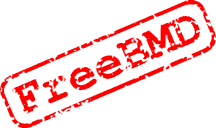
 Transcribing Scanned Source
Transcribing Scanned Source
 Transcribing Scanned Source
Transcribing Scanned SourceTranscribing from the scanned images is very similar to transcribing from the original film, and there are just a few administrative points that you need to be aware of. If you are new to transcribing you might want to read Information for New Transcribers first. Experienced and new transcribers may like to take advantage of some hints and tips which will enable you to make the most of the scanned images.
ACDB-ANC-DB-EW-Fiche-JM-LDS-LOMEL-MKL-NFHC-OFHS-ONS-UKC-UKD-1837M3-A-C-0134x.gif
(1837 Marriages, Quarter 3, Index A-C, Page 134)
1866M3-G-0134.tif
x and the lower half y.
There should always be an overlap between the two halves.
-1, -2 etc.
If this affects you, then you should download all copies, as one copy may be easier to read
than the other on certain entries.
-rescan.
Once again, you should download all copies.
Transcribers are recommended to use WinBMD.
SpeedBMD version 1.9 or higher is also suitable, but it is limited to an <8 character>.<3 character> filename naming convention since it is a DOS program.
66M30134.SCA
(1866 Marriages, Quarter 3, Page 134)
66M30134
C:\SPEEDBMD\66M30134.SCA
A very easy to use and useful image viewer is available free from any one of these sites. If one is not available or slow to access, the other one should be available.
| Q | A |
|---|---|
| What software do I need to use the download the scans? | Your ordinary internet browser, and possibly a graphics package capable of reading GIF,
JPEG or TIFF
files (Microsoft Imager for example). See the Hints and Tips for information about
the sort of features your graphics package should have. |
| How big are the images? | Obviously the images vary in size, but most are about 100-200 kb in size. |
| What software do I need to transcribe the data? | You don't actually need any special software, you can just key the data into a text editor. We strongly recommend that you download SpeedBMD (by Peter Cox) or WinBMD (by Ian Brooke), which are both free programs to speed up the job. And there is also another free program called BMDVerify (by David Lang) which is useful for checking. |
| How do I get my first allocation? | When you register with the syndicate, you will be allocated a page to transcribe and upload. |
| How do I get more allocations? | Your coordinator will tell you how to get more allocations when he sends you your first allocation. |
| How do I access the scans? | Click on the appropriate alphabetic range in the scan table or follow the instructions given by your co-ordinator. |
| What about entries that are hard to read? | If you have difficulty in reading some entries, you should read the information about representing uncertain characters on the Beginner's Help page. If you are transcribing from handwritten material, you may also find the page about reading Victorian handwriting useful. |
| What do I call my file? | See the information above concerning the naming of Data files. |
| What do I do with my file once I've transcribed it? | Upload it to FreeBMD via the File Management Screen. Help on this process can be found in the Beginner's Help page. |
| Search engine, layout and database
Copyright © 1998-2025 Free UK Genealogy CIO, a charity registered in England and Wales, Number 1167484.
We make no warranty whatsoever as to the accuracy or completeness of the FreeBMD data. Use of the FreeBMD website is conditional upon acceptance of the Terms and Conditions |
 |